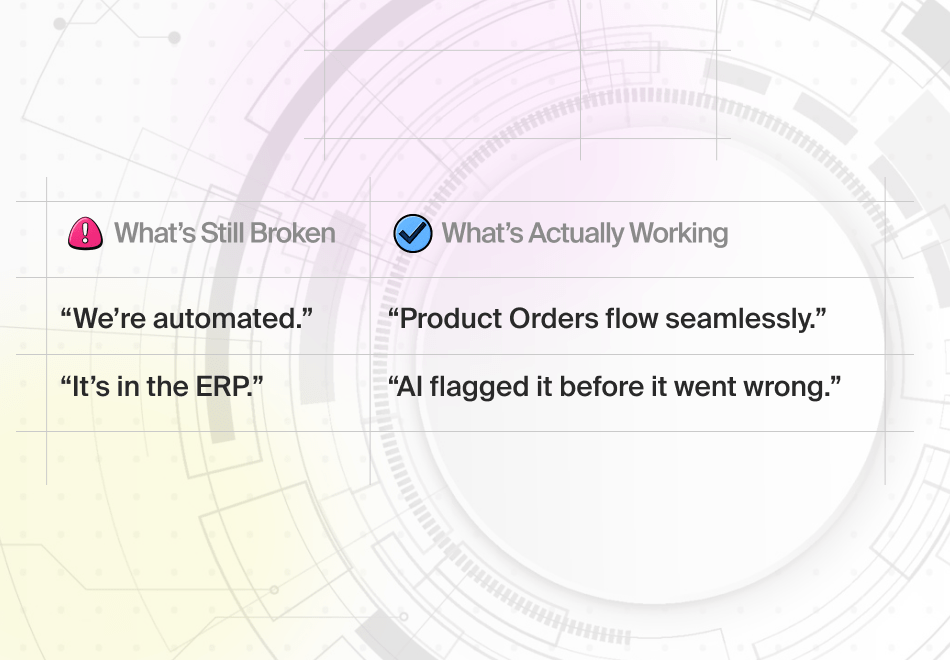At a Glance
Today, growing companies need to keep tighter reins over their inventories. Having too much on hand means capital outlays will suffer. Too little could mean trouble meeting unexpected demands. Materials requirements planning (MRP) allows companies to better plan their production, ensuring needed supplies are available without hampering other business functions. The benefits of using MRP software, like that found in Microsoft Dynamics 365 Supply Chain Management, include:
- Proper MRP and supply chain planning acts as a catalyst for growth
- Ability to better manage customer expectations and reality behind the scenes
- Addressing real-life pain points becomes easier
- Ability to plan production campaigns in advance
- Easier to overcome resistance to change while adapting to newer, more efficient planning methods
Supply Chain Planning Methods Benefit All Companies
Whether you’re a bakery or a pharmaceutical manufacturing company, planning your inventory is an essential part of daily operations. If a bakery does not order enough flour, yeast, or eggs, it can’t meet customer demands. Order too much and the company loses money from spoiled or wasted materials.
When it comes to chemical companies, managing waste is not as simple as throwing away a loaf of bread. The repercussions to unplanned operations in highly regulated industries can be significantly worse: Creating bad batches of hazardous or volatile chemicals, along with continuously yielding unplanned co-products or by-products will require additional storage or disposal based on quality tests.
For another example, consider a pharmaceutical company. The production of batches with a lower than planned potency can easily result in an over-extended campaign, the over-consumption of raw materials and lower production yields. If a batch is planned for a certain potency, the production process can’t be considered complete until the quality department confirms it meets the required specifications. Then, after reworking the batch a few times, it may even be reclassified to a lower potency when it does not yield the desired results.
While the concept of MRP was originally intended for manufacturing companies, it now extends itself into all industries, including those whose products are services.
MRP can be even more critical in small-to-medium manufacturing companies: the smaller a company is, the more precise the allocation materials and resources needs to be. These planners and buyers need clear and precise signals allowing them to make informed decisions on when to buy, and when to produce. The availability of materials and capacity of resources is everything in optimizing and streamlining a plant’s supply chain.
Especially today, MRP should be included as part of optimizing a company’s overall supply chain. This is one of the reasons were seeing MRP integrated into Enterprise Resource Planning (ERP) software more and more. Combined with other parts of supply chain management, MRP lets companies offer their customers a better experience along with the added benefit of lower inventory costs.
A Real-Life Example
Customer A requests a quote for a specific product they need quickly. This customer has already reached out to secondary vendors for quotes.
In order to please this customer, especially with added competition, may require a thorough inventory evaluation to know if you can meet their deadline.
Without a proper MRP system in place, it’s likely you’ve had to develop and manage dozens of complex spreadsheets with sales orders, supply and demand forecasts, production schedules and more. After that, you’ll probably have to superimpose inventory availability and resource capacities into the same spreadsheet. Does this sound familiar?
This method can take 2-3 days just to determine if you can meet their deadline. The work and precision required puts tremendous pressure on planners, alienates customers and impairs organizational growth. Competitors with an MRP system integrated into their ERP platform can provide a realistic promise date significantly quicker than companies still relying on manual methods.
Without the ability to provide reliable available-to-promise (ATP) dates, you can easily lose customers to suppliers able to commit and deliver on time.
Meeting customer demands by a certain date requires at least three inputs:
- 1.Planned supply
- 2.On-hand availability after all allocations and reservations are considered
- 3.Resource capacity

What Happens on the Ground?
Preparing a production schedule can be a challenge if you don’t have a complete understanding of inventory levels, labor and resource availability. Even with a forecast in place, it’s hard to efficiently schedule production if you’re facing capacity issues. This Standard Costing in Pharmaceutical Manufacturing – Industry Challenges and Solutions offers an example of the batch manufacturing processes and the data inaccuracies that can occur while consuming inventory. Add these data inaccuracies on top of lack of resource capacity and the challenge should be clear.
These problems illustrate the need for accurate production planning and scheduling, which are critical in any manufacturing or distribution company, especially if youre trying to streamline operations.
Not only do customers often expect 99 percent-plus service levels within 24 to 48 hours, but supply reliability is also becoming more tenuous as once local supply chains now extend around the world.
Being able to boost production efficiency with accurate inventory plans is becoming critical in today’s business environment. Companies face constant pressure to perform at a higher level, especially with growing competition and customer loyalty seen as directly connected to a company’s perceived value.
Meeting Customer Demands
It’s important to know your planner is able to meet the demand of your customers, along with being able to relay and provide important information, including things like:
- Resource availability
- Production capacity
- Overall demand
- Quality requirements
- Batch potency requirements
Without even basic planning, a company operating reactively will lose inventory and suffocate resource availability, resulting in a considerable waste of time and money. Systems that can take advantage of modern technologies like AI an ML can generate needed results in minutes much more efficiently. That’s where a system like Microsoft Dynamics 365 Supply Chain Management comes in.

Not being able to track capacity means waiting for one machine operation to finish before the next job starts. Knowing how long each process takes is crucial in providing a reliable promise date. Companies who aren’t able to meet customer deadlines can easily lose any edge they may have over their peers. Continuing to operate without proper supply chain planning, companies stunt their own growth.
Interested in learning how Microsoft Solutions can help your your company?
Benefits of an Integrated MRP and Forecasting System
An integrated materials requirement planning and forecasting system offers much better control over production. These systems can take advantage of different coverage settings like lead times and time fences for upcoming projects, and creates production signals based on material availability plus resource capacity and capability.
The system’s built-in algorithms take into account all products that require planning while sharing the same raw materials and resources. It shows the planner schedules for all material requirements to meet supply and demand based on the calendar with working time.
The planner is able to access a similar visual schedule to what they would create manually on a spreadsheet but with much more functionality and the ability to make informed decisions. The planner can then decide how and where reprioritization needs to happen and then which lot production runs to schedule first.
A good MRP algorithm empowers users to be able to proactively plan, letting them keep better tabs on raw materials and resource allocations. On top of that, being able to add stringent production floor operating procedures with stop gaps can help reduce or eliminate uncontrolled activities that can alter inventory projections.
Role of People
Having a well-trained, experienced workforce is invaluable. It’s undoubtedly your biggest strength. But because some people are comfortable performing tasks a specific way, they may find it challenging to adapt to changes designed to streamline your supply chain. How do you convert workers who are unwilling to change?
Some proven ways are:
- Educating your workforce on how adapting to newer methods and tools to increase supply chain optimization benefits them
- Explaining and showing them how the modern tools are actually simpler to use and follow standard execution methods
- Creating a change management process
- Involving them in the overall transformation from no planning or manual planning to a systematized planning and scheduling tool
- Teaming your workforce with newer team members who act as change agents during the software implementation process
40%
More than 40% of financial services executives feel cultural or behavioral change is the biggest challenge they face in pursuing their technology transformation.
Source: Inference from McKinsey
Key Takeaways
There are several steps any company can take to proactively plan its supply chain. These include:
- Looking at current cycle count procedures and then re-categorizing the top items for better visibility
- Using better time and management procedures to better allocate resources to the right jobs
- Providing proper handoffs for machines and operators from one step in the production process to the next
- Proactively scheduling jobs and finding more efficient operating methods
Finally, ask yourself this question: Is your company on pace to beat your competition right now or are you lagging behind? Could MRP help you capture more sales and improve the customer experience by letting you deliver quotes faster and meet, or beat existing production deadlines?
If you aren’t getting ahead maybe it’s time to take a closer look at how Microsoft Dynamics 365 Supply Chain Management can help.








